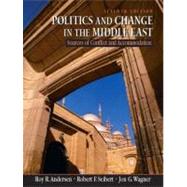
| Preface | xi | ||||
| Introduction | xv | ||||
|
xvi | ||||
|
xvii | ||||
| CHAPTER ONE Traditional Cultures of the Middle East: The Cradle of Civilization and Politics | 1 | (10) | |||
|
3 | (5) | |||
|
8 | (3) | |||
| CHAPTER TWO The Foundations of Islam | 11 | (15) | |||
|
12 | (2) | |||
|
14 | (1) | |||
|
15 | (2) | |||
|
17 | (5) | |||
|
22 | (3) | |||
|
25 | (1) | |||
| CHAPTER THREE The Political Legacy of Islam, A.D. 632-1800 | 26 | (17) | |||
|
27 | (1) | |||
|
28 | (3) | |||
|
31 | (3) | |||
|
34 | (1) | |||
|
35 | (1) | |||
|
36 | (1) | |||
|
37 | (1) | |||
|
38 | (1) | |||
|
39 | (1) | |||
|
39 | (1) | |||
|
39 | (2) | |||
|
41 | (2) | |||
| CHAPTER FOUR Western Imperialism, 1800-1914 | 43 | (13) | |||
|
44 | (1) | |||
|
45 | (2) | |||
|
47 | (2) | |||
|
49 | (1) | |||
|
50 | (1) | |||
|
51 | (3) | |||
|
54 | (2) | |||
| CHAPTER FIVE The Rise of the State System, 1914-1950 | 56 | (16) | |||
|
57 | (3) | |||
|
60 | (2) | |||
|
62 | (2) | |||
|
64 | (1) | |||
|
65 | (2) | |||
|
67 | (3) | |||
|
70 | (2) | |||
| CHAPTER SIX The Drive for Self-Determination, 1950-1990 | 72 | (33) | |||
|
73 | (10) | |||
|
83 | (6) | |||
|
89 | (10) | |||
|
99 | (5) | |||
|
104 | (1) | |||
| CHAPTER SEVEN Turning Points | 105 | (21) | |||
|
107 | (3) | |||
|
110 | (3) | |||
|
113 | (6) | |||
|
119 | (5) | |||
|
124 | (2) | |||
| CHAPTER EIGHT The Politics of Religion, Culture, and Social Life | 126 | (27) | |||
|
127 | (2) | |||
|
129 | (3) | |||
|
132 | (3) | |||
|
135 | (3) | |||
|
138 | (4) | |||
|
142 | (4) | |||
|
146 | (5) | |||
|
151 | (2) | |||
| CHAPTER NINE Political Elites | 153 | (24) | |||
|
156 | (20) | |||
|
176 | (1) | |||
| CHAPTER TEN Political Leadership in the Contemporary Middle East | 177 | (24) | |||
|
177 | (4) | |||
|
181 | (3) | |||
|
184 | (2) | |||
|
186 | (1) | |||
|
187 | (2) | |||
|
189 | (7) | |||
|
196 | (4) | |||
|
200 | (1) | |||
| CHAPTER ELEVEN The Economic Setting | 201 | (34) | |||
|
204 | (1) | |||
|
205 | (6) | |||
|
211 | (1) | |||
|
211 | (4) | |||
|
215 | (1) | |||
|
216 | (3) | |||
|
219 | (7) | |||
|
226 | (1) | |||
|
227 | (6) | |||
|
233 | (2) | |||
| CHAPTER TWELVE International Relations in the Contemporary Middle East, 1945-1990 | 235 | (17) | |||
|
238 | (2) | |||
|
240 | (6) | |||
|
246 | (3) | |||
|
249 | (1) | |||
|
250 | (1) | |||
|
251 | (1) | |||
| CHAPTER THIRTEEN International Relations in the Contemporary Middle East, 1945-1990: The Regional Actors | 252 | (27) | |||
|
256 | (3) | |||
|
259 | (1) | |||
|
260 | (18) | |||
|
278 | (1) | |||
| CHAPTER FOURTEEN The Middle East and the Changing International Order, 1991-2001 | 279 | (30) | |||
|
281 | (1) | |||
|
282 | (9) | |||
|
291 | (6) | |||
|
297 | (2) | |||
|
299 | (8) | |||
|
307 | (2) | |||
| CHAPTER FIFTEEN Did 9/11 Change Everything? | 309 | (15) | |||
|
310 | (2) | |||
|
312 | (1) | |||
|
313 | (1) | |||
|
314 | (3) | |||
|
317 | (1) | |||
|
318 | (5) | |||
|
323 | (1) | |||
| Internet Resources | 324 | (2) | |||
| Glossary | 326 | (3) | |||
| Index | 329 |
The New copy of this book will include any supplemental materials advertised. Please check the title of the book to determine if it should include any access cards, study guides, lab manuals, CDs, etc.
The Used, Rental and eBook copies of this book are not guaranteed to include any supplemental materials. Typically, only the book itself is included. This is true even if the title states it includes any access cards, study guides, lab manuals, CDs, etc.